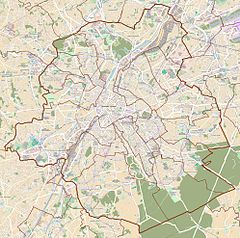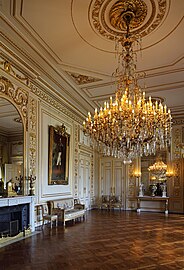Royal Palace of Brussels
| Royal Palace of Brussels | |
|---|---|
| |
 Main façade of the Royal Palace of Brussels (constructed 1904) | |
 Location within Brussels | |
| General information | |
| Type | Palace |
| Architectural style | Neoclassical |
| Location | Brussels, Belgium |
| Coordinates | 50°50′30″N 04°21′44″E / 50.84167°N 4.36222°ECoordinates: 50°50′30″N 04°21′44″E / 50.84167°N 4.36222°E |
| Current tenants | Monarchy of Belgium |
| Construction started | 1783 |
| Completed | 1934 |
| Client | Leopold II |
| Owner | Belgian federal government |
| Technical details | |
| Floor area | 33,027m2 (355,500ft2) |
| Design and construction | |
| Architect |
|
| Other designers | François Rude, Jan Fabre |
| Website | |
| Official website | |
| References | |
| [1] | |
The Royal Palace of Brussels (Dutch: Koninklijk Paleis van Brussel [ˈkoːnɪŋklək paːˈlɛis fɑm ˈbrʏsəl],[2] French: Palais Royal de Bruxelles, German: Königlicher Palast von Brüssel) is the official palace of the King and Queen of the Belgians in the centre of the nation's capital Brussels. However it is not used as a royal residence, as the king and his family live in the Royal Palace of Laeken on the outskirts of Brussels. The website of the Belgian Monarchy describes the function of the palace as follows:
The Palace is where His Majesty the King exercises his prerogatives as Head of State, grants audiences and deals with affairs of state. Apart from the offices of the King and the Queen, the Royal Palace houses the services of the Grand Marshal of the Court, the King's Head of Cabinet, the Head of the King's Military Household and the Intendant of the King's Civil List. The Palace also includes the State Rooms where large receptions are held, as well as the apartments provided for foreign Heads of State during official visits.
The palace is situated in front of Brussels Park. A long square called the Paleizenplein/Place des Palais separates the palace from the park. The middle axis of the park marks both the middle peristyle of the palace and the middle of the facing building on the other side of the park, which is the Palace of the Nation (the Belgian Federal Parliament building). The two facing buildings are said to symbolize Belgium's system of government: a constitutional monarchy.
History[]
The facade existing today was only built after 1900 on the initiative of King Leopold II. The first nucleus of the present-day building dates from the end of the 18th century. However, the grounds on which the palace stands were once part of the Coudenberg Palace a very old palatial complex that dated back to the Middle Ages.[1]

The first building on the Coudenberg hill was constructed between the second half of the 11th and first half of the 12th century. At that time it probably looked like a fortified castle forming a part of the fortifications of the city of Brussels. It was the home of the Dukes of Brabant who also resided in the nearby city of Leuven and in the Castle of Tervuren. In the following centuries it was rebuilt, extended and improved in line with the increased prestige of the Dukes of Brabant and their successors; the Dukes of Burgundy, the Emperor Charles V, the Archduke Albert of Austria and Infanta Isabel of Spain and successive Governors of the Habsburg Netherlands.
The Aula Magna, or Throne Room, was built for Philip the Good in the 15th century. It was in this room that the Emperor Charles V abdicated in 1555 in favour of his son Philip II of Spain. This impressive complex suffered several fires over the centuries. In 1679 a fire destroyed part of the roof. A large fire that broke out on 3 February 1731 almost completely destroyed the building. Only the court chapel and the walls of the Aula Magna were somewhat spared.[3] The ruins only disappeared when the district was redeveloped after 1775. At that time the urban axes of the present-day Brussels Park were laid out. The Place Royale was built on top of the ruined palace. Excavations of the site by different archeological organisations have unearthed various remains of different parts of the Palace as well as the surrounding town. The monumental vaults remaining under the square and its surrounding buildings can be visited.

The New Palace[]
Charles Alexander of Lorraine, at that time Governor of the Habsburg Netherlands had a new palace, the Palace of Charles of Lorraine, built on the nearby site of the former palace of the Nassau family (Hof van Nassau). The Palace of Charles of Lorraine is now part of the Royal Library of Belgium. The old palace garden was redesigned as a public park. On the north side a new building for the Council of Brabant (Raad van Brabant / Conseil de Brabant) was built by the French architect , which today houses the Belgian Federal Parliament and is known as the 'Palace of the Nation'. On the other side of the park (the building plot of the present-day palace) the middle axis of the park continued as a street between two newly built mansions. One served as the residence of the Abbot of the nearby Coudenberg Abbey, while the other was inhabited by important government members.
After the Congress of Vienna in 1814, Brussels became (together with The Hague) the joint capital of the new established United Kingdom of the Netherlands. It was under the rule of William I of the Netherlands that the street was covered and the two mansions were joined with a gallery. The newly created 'palace' received a new neo-classic facade designed by Tilman-François Suys with a peristyle in the middle, and a balcony with a wrought iron parapet surrounding the entire first floor.

The street running alongside the new palace was widened and thus the Place des Palais or Paleizenplein was created. The new square was called 'Square of the Palaces' in plural, because another palace was built on the left side of the Royal Palace. This new building (1823) was designed as the residence of the Crown Prince called the Prince of Orange (the later King William II of the Netherlands). Today it houses the Royal Academies of Sciences and Arts of Belgium and is consequently called Academiënpaleis / Palais des Academies. The rooms and 'Salons' of the old mansions were incorporated in the new Royal Palace and were only partly refurnished. Some of them survived al the 19th and 20th century renovations and are still partly intact today. A major addition to the interior decoration from the time of William I is the so-called 'Empire room' which was designed as a ballroom. It has a very refined cream and gold decoration designed and executed by the famous French sculptor François Rude.
Extensions by Leopold II[]

After the Belgian revolution the palace was offered to Leopold of Saxe-Coburg when he ascended the throne as the first King of the Belgians. Just like his predecessor William II he used the palace mainly for official receptions and other representational purposes and lived in the Royal Palace of Laeken. During his reign (until 1865) little was changed to the palace. It was his son and successor Leopold II who judged the building to be too modest for a king of his stature, and who kept on enlarging and embellishing the palace until his death in 1909. During his reign the palace nearly doubled in surface. After the designs of his architect Alphonse Balat, imposing rooms like the 'Grand Staircase', 'Throne Room' and the 'Grande Gallerie' were added. Balat also planned a new façade but died before the plans could be executed.
It was only after 1904 that the new façade was executed after new plans by Henri Maquet. The pediment sculpture shows an allegorical figure of Belgium flanked by groups representing Industry and Agriculture, by Belgian sculptor Thomas Vinçotte. The new design included a formal front garden separating the building from the 'Place des Palais'.
As often mentioned, it has a facade 50% longer than that of Buckingham Palace[4] but its floor area of 33,027 m2 is less than half of Buckingham Palace's floor area (77,000 m2).[5]
Royal Collection[]
In the palace an important part of the royal collection is found. This consists of mainly state portraits and important furniture of Napoleon, Leopold I, King Louis Philippe and Leopold II. Silverware, porcelain and fine crystal is kept in the cellars used during state banquets and formal occasions at court. Queen Paola added modern art in some of the state rooms.
During state visits, the royal apartments and suites are at the disposal of visiting heads of state. Ambassadors too are received here with state ceremony. New Year's receptions are held for NATO, ambassadors of the EU and politicians. Royal wedding banquets take place in the palace, and after their death, the body of the deceased king lies in state here. If the king is currently in the country, the flag is hoisted on the central building. If he is present inside the palace then the Honor Guard stands at the front of the palace.
Gallery[]

German soldiers parade past the palace, May 1940
The Royal Palace from the northeastern corner

The Royal Palace viewed from Brussels' Park during winter

The King during a private audience in his Office

The Hall of Mirrors during a reception of the EU ASEM summit in 2010

The Throne Room

The Grand White Drawing Room
See also[]
- List of castles in Belgium
- Royal Castle of Laeken residence of the King
- Monarchy of Belgium
References[]
- ^ Jump up to: a b Ministère de la culture française (1994). "Le Palais Royal". Le patrimoine monumental de la Belgique / Bruxelles (in French). Liège: Editions Mardaga. pp. 57–67. ISBN 2870095627. Retrieved 9 April 2012.
- ^ In isolation, van is pronounced [vɑn].
- ^ Rudi Schrever, Paleis op de Coudenberg in: Historiek, 28 September 2014 (in Dutch)
- ^ 10 fun facts Brussels
- ^ Buckingham Palace Fact Sheet
Further reading[]
- André Molitor. The Royal Palace in Brussels. Musea Nostra. Ghent, Crédit Communal & Ludion, 1993.
- Liane Ranieri. Léopold II urbaniste (Leopold II as town planner). Brussels, Hayez, 1973.
- Irène Smets. The Royal Palace in Brussels. Ghent, Ludion, 2000.
- Arlette Smolar et al., Le Palais de Bruxelles (The Palace of Brussels). Huit siècles d'art et d'histoire (Eight centuries of art and history). Brussels, Crédit Communal, 1991.
- Thierry Van Oppem. 'Aux origines du Palais Royal de Bruxelles, un hôtel ministériel de la fin du XVIIe siècle'. ("The origins of the Royal Palace of Brussels, a late 17th century ministerial mansion"). Maison d'Hier et d'Aujourd'hui, 1991.
External links[]
| Wikimedia Commons has media related to Royal Palace, Brussels. |
- Palace of Brussels, official website
- Houses completed in the 18th century
- Houses completed in the 19th century
- Palaces in Brussels
- Royal residences in Belgium
- Neoclassical architecture in Belgium
- City of Brussels







